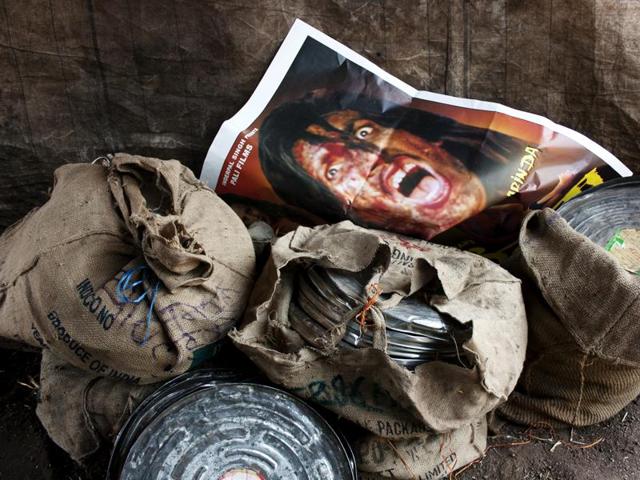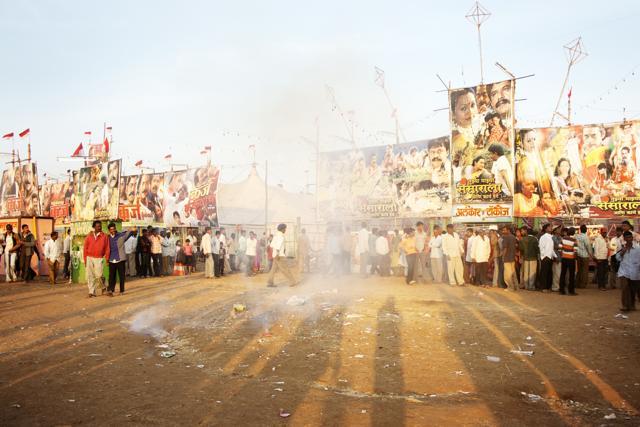Cinema Travellers: Tracing the decline of tent cinema in India
An Indian documentary that traces the decline of the tent cinema industry is set to premiere at Cannes on May 15
Watching a film in a village is such a physical experience, says documentary filmmaker Shirley Abraham. “In the interval, you peep into the projector’s shed and ask how much is left. Sitting in the tent you can smell the carbon arc lamp of the projector. hear the whirring, feel the earth under you. Cinema is lived here.”

Or it used to be. Abraham and her colleague Amit Madheshiya are currently in the midst of prepping their documentary, The Cinema Travellers, for its premiere at the Cannes Film Festival on May 15.
The film is about how cable TV and the internet are pushing the once-hugely-popular tambu talkies or pop-up tent cinemas into oblivion. The Cinema Travellers has been selected for premiere in the Cannes Classics selection, dedicated to cinema on cinema.

While Abraham, 33 and a research scholar, has donned the hats of co-director, editor, co-producer and sound recordist, Madheshiya, also 33, and a photographer, acts as co-director, cinematographer, co-producer and editor. The duo dedicated more than five years to the film.
“In 2006, single-screen theatres suddenly began shutting down in droves in the cities,” says Madheshiya. “It moved us to think that these iconic spaces, with all their collective memories, were being razed. And we thought: If this is happening in the cities, what is happening in the villages? This led to our exploration of the decline of travelling cinemas.”
Read: Alternate models of cinema catering to rural and semi-urban audience
Maharashtra was selected as the canvas since it was here that the tambu talkies industry was most organised, and simultaneously most rooted in tradition. They had existed for almost eight decades, preserving a sense of what cinema had first looked like. “These were the only people in the country who were still working only with actual film roll,” says Madheshiya. “We also visited rural Bengal, Bihar and Uttar Pradesh but were spellbound by the story of Maharashtra.”
Before the tambu talkies, lavani and tamasha had been the sources of entertainment in this region, and they were meant only for men. “It was at the tent cinemas that popped up during religious events and fairs that women would get together for an afternoon of watching mythological features in public,” says Abraham.
As recently as 1991, the Marathi film Maherchi Sadi ran to packed houses throughout the November-to-May post-harvest season. “The star, Alka Kubal, was known as the Madhuri Dixit of Marathi cinema,” says Madheshiya. “Up to 2,000 people would crowd under each tent, watch it and stay for the re-runs, the cinema tent owners say.”
The filmmaking duo first caught up with one of the tambu talkies in 2008. “When we saw them for the first time, they seemed timeless,” says Abraham, of the multi-coloured trucks and tents featuring the faces of the stars. “They were still using little movable projectors. And the people were still coming, but had dwindled to hundreds.”
The duo went back every year for the next six years, and saw how the number of tambu talkies doing the rounds was falling. In 2008, there were 10 per village during the six-month season; by 2009, there were only 3.
Read: On the phenomenon of slum cinemas and discover cinema-maps of Mumbai
“This documentary is a homage to the ‘cinema travellers’ -- people who travel in different dimensions, physically and through their imagination,” says Abraham.
The golden age of tent cinema began in the 1940s and ended when the markets were opened up during the liberalisation of the early 1990s.
The Cinema Travellers tracks the change that followed through the failing fortunes of two showmen, one in late 30s and one in his 40s, and a repairman in his late 60s who tends to overused projectors. As their audiences move on, the first showman now sells cold drinks every summer; the second has resigned himself to farming and the repairman had his shop repeatedly broken into by thieves, leaving him with nothing. He is retired.

The project was supported by the India Foundation for the Arts, Bengaluru; Cluster of Excellence, Heidelberg; and Goethe-Institut / Max Mueller Bhavan, New Delhi, and its selection by the Sundance Music and Sound Design Lab in 2015, a residency that mentors filmmakers in storytelling and post-production, led the filmmaker duo to hone what would turn out to be a key aspect of their tale: Sound.
“We worked on sound in one of the best facilities, Skywalker Sound in California, built by George Lucas [creator of Star Wars],” says Madheshiya. “It was there that we decided to use the whirring of the projector, which was a huge part of my experience of the travelling cinemas. By the time we were done, the projector had become like a living organism, almost a character of its own in our film.”
The film also recreates the ambience through sound -- the experience of watching a film in the midst of a village fair, separated from the bustle only by a thin tent. “We like to think that, in the end product, you can sense the throng of the fair ‘outside’ through various sounds,” Madheshiya says, “ just as you would once have been able to while watching Mithun Chakraborty bash the baddies in the middle of rural Maharashtra.”
Follow @htshowbiz for more.
Get more updates from Bollywood, Taylor Swift, Hollywood, Music and Web Series along with Latest Entertainment News at Hindustan Times.



